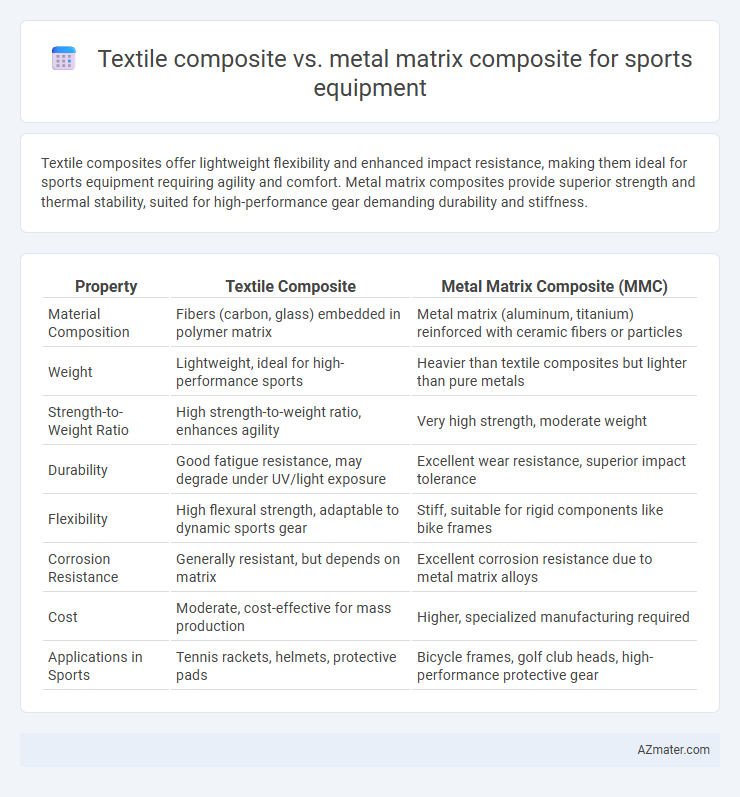Textile composites offer lightweight flexibility and enhanced impact resistance, making them ideal for sports equipment requiring agility and comfort. Metal matrix composites provide superior strength and thermal stability, suited for high-performance gear demanding durability and stiffness.
Table of Comparison
| Property | Textile Composite | Metal Matrix Composite (MMC) |
|---|---|---|
| Material Composition | Fibers (carbon, glass) embedded in polymer matrix | Metal matrix (aluminum, titanium) reinforced with ceramic fibers or particles |
| Weight | Lightweight, ideal for high-performance sports | Heavier than textile composites but lighter than pure metals |
| Strength-to-Weight Ratio | High strength-to-weight ratio, enhances agility | Very high strength, moderate weight |
| Durability | Good fatigue resistance, may degrade under UV/light exposure | Excellent wear resistance, superior impact tolerance |
| Flexibility | High flexural strength, adaptable to dynamic sports gear | Stiff, suitable for rigid components like bike frames |
| Corrosion Resistance | Generally resistant, but depends on matrix | Excellent corrosion resistance due to metal matrix alloys |
| Cost | Moderate, cost-effective for mass production | Higher, specialized manufacturing required |
| Applications in Sports | Tennis rackets, helmets, protective pads | Bicycle frames, golf club heads, high-performance protective gear |
Introduction to Composite Materials in Sports Equipment
Textile composites, composed of woven fibers like carbon or aramid embedded in polymer matrices, offer high strength-to-weight ratios and excellent flexibility, making them ideal for sports equipment such as tennis rackets and protective gear. Metal matrix composites (MMCs), combining metal matrices with ceramic or fiber reinforcements, provide superior stiffness, wear resistance, and thermal stability, favored in high-performance applications like bicycle frames and golf club heads. These composite materials enhance athletic performance by optimizing durability, weight, and responsiveness tailored to specific sports requirements.
Overview of Textile Composites
Textile composites in sports equipment combine high-strength fibers like carbon, aramid, or fiberglass with polymer matrices to deliver lightweight, flexible, and impact-resistant properties ideal for dynamic athletic performance. Their multidirectional fiber orientations enhance fatigue resistance and energy absorption, making them superior in applications such as helmets, rackets, and protective gear. Compared to metal matrix composites, textile composites offer better vibration damping, corrosion resistance, and ease of tailoring mechanical properties to specific sports requirements.
Overview of Metal Matrix Composites
Metal Matrix Composites (MMCs) feature metal alloys reinforced with ceramic fibers or particles, offering superior strength-to-weight ratios and enhanced thermal stability compared to traditional materials. MMCs improve impact resistance and fatigue life, making them ideal for high-performance sports equipment such as bicycle frames, golf clubs, and helmets. Their superior wear resistance and stiffness provide athletes with durable, lightweight gear that can withstand rigorous use and improve overall performance.
Mechanical Properties Comparison
Textile composites exhibit high tensile strength and superior flexibility, making them ideal for sports equipment requiring lightweight durability and impact resistance. Metal matrix composites offer enhanced stiffness, thermal stability, and wear resistance, suitable for high-performance gear subjected to extreme mechanical stress. The mechanical property comparison highlights textile composites as optimal for agility and energy absorption, while metal matrix composites excel in load-bearing capacity and structural integrity.
Weight and Performance Impact
Textile composites offer significant weight reduction compared to metal matrix composites, making them ideal for sports equipment requiring agility and speed, such as helmets and bicycle frames. Metal matrix composites provide superior strength and durability but tend to be heavier, affecting the overall weight and maneuverability of gear like golf clubs or racquet frames. The choice between these materials directly impacts performance by balancing lightweight design with the necessary rigidity and impact resistance needed in various sports applications.
Durability and Longevity
Textile composites used in sports equipment offer superior flexibility and impact resistance, enhancing durability under repetitive stress and reducing fatigue over time. Metal matrix composites provide exceptional strength and stiffness, contributing to prolonged structural integrity and resistance to wear in high-performance applications. The choice between textile and metal matrix composites depends on balancing lightweight flexibility with the need for high resilience and longevity in specific sports equipment contexts.
Design Flexibility and Customization
Textile composites offer superior design flexibility and customization for sports equipment due to their lightweight nature and ability to be molded into complex shapes, enhancing ergonomic performance. Metal matrix composites, while providing exceptional strength and durability, have limitations in customization because of their rigid manufacturing processes and higher density. The ability of textile composites to tailor fiber orientation and weave patterns allows manufacturers to optimize equipment for specific sports applications and athlete needs.
Cost Considerations
Textile composites exhibit lower production costs compared to metal matrix composites, primarily due to less expensive raw materials and simpler manufacturing processes. Metal matrix composites demand high energy consumption and specialized equipment, escalating initial investment and maintenance expenses. The cost-effectiveness of textile composites makes them preferable for sports equipment requiring lightweight performance without substantial financial burden.
Environmental Sustainability
Textile composites in sports equipment offer superior environmental sustainability due to their biodegradable fibers and lower energy consumption during manufacturing, reducing carbon footprints compared to metal matrix composites. Metal matrix composites often involve energy-intensive processing and reliance on non-renewable metals, leading to higher environmental impact and recycling challenges. Lightweight textile composites also enhance equipment lifespan and end-of-life recyclability, promoting sustainable sports practices.
Applications in Modern Sports Equipment
Textile composites, known for their lightweight and high tensile strength, are extensively used in sports equipment such as tennis rackets, helmets, and protective gear, enhancing flexibility and impact resistance. Metal matrix composites offer superior stiffness and thermal stability, making them ideal for high-performance applications like bicycle frames and golf clubs where durability and stiffness are critical. The choice between these composites in modern sports equipment depends on the specific performance requirements, balancing weight, strength, and wear resistance.

Infographic: Textile composite vs Metal matrix composite for Sports equipment
 azmater.com
azmater.com